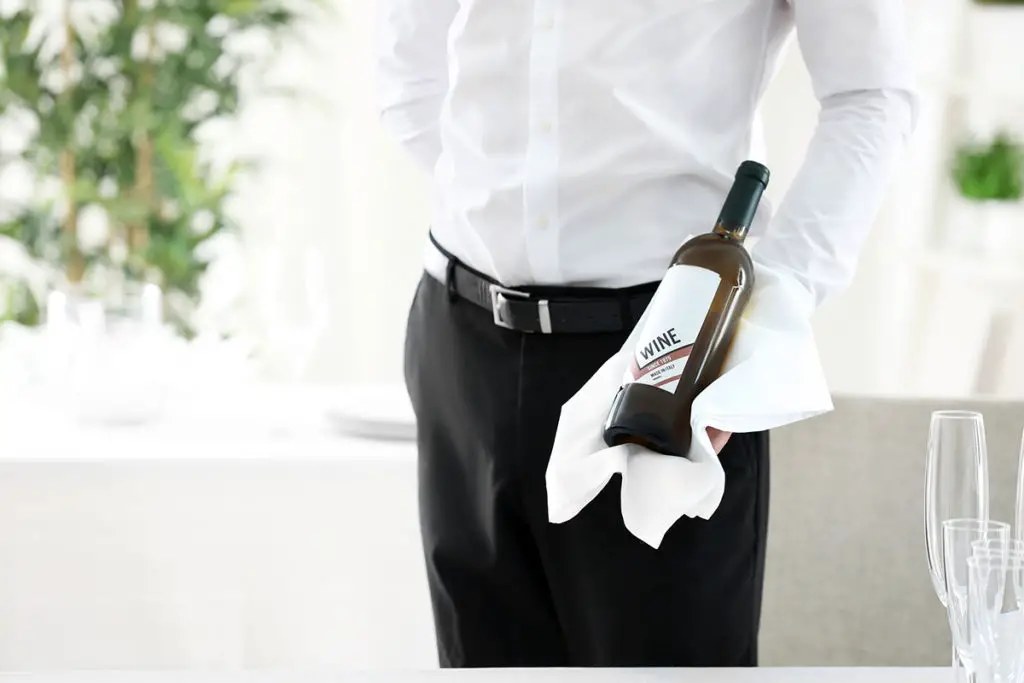Cleaning is an essential part of the winemaking process. Everything used during the process must be properly cleaned and sanitized before coming into contact with ingredients, especially the bottles. But what is the right way to sanitize wine bottles?
The correct way to sanitize wine bottles is to use both chemical sanitizing agents and heat. Microorganisms able to survive one or the other will not survive both. Both used and new wine bottles must be cleaned and sanitized before being filled.
This article will explain the proper method for sanitizing wine bottles. But first, it will explain why proper cleaning and sanitization are necessary.
Why Are Cleaning and Sanitization of Wine Bottles Necessary?
Proper cleaning and sanitization are necessary to preserve the quality and safety of your wine. Unseen particulate matter and winemaking residue can ruin the taste of your wine. Also, some microorganisms can survive in an alcohol-rich environment and potentially make humans sick.

Gold Medal Wine Club - Boutique, award-winning wines delivered monthly! → Choose Your Wines
Cleaning can be described as removing contaminants you can see. Sanitation is removing contaminants you can’t.
Whether your wine bottles are new or used, there are probably things in them that you do not want in your wine. These contaminants can be as benign as dust and residue from the glass-making process or as dangerous as black mold or bacteria from the staphylococcus family.
If you are working with new bottles, the hope would be that the manufacturer would clean and sanitize the bottle before shipping them.
But honestly, you never know. For instance, the bottles may have been sitting in a warehouse for an undetermined period of time.
If you use used bottles, there will be leftover sugar and congeners from the bottles’ previous contents. These can serve as growth media from some unpleasant microorganisms and will ruin the flavor of any new wine.
Many professional winemakers advise against reusing wine bottles unless you know exactly where they’re from.
How To Clean Wine Bottles
Wine bottles should be cleaned inside and out before being used to store homemade wine. You will need the following materials and tools:
- Hot Water
- Cleaning solution
- A bottle brush
- Thick rubber or latex gloves
- (Optional) A power drill
Bottle brushes are essentially elongated toilet brushes or pipe cleaners with longer bristles. No products found. available on Amazon.com or from winemaking supply companies in a pack of three. Or, you can buy a No products found. available on Amazon.com for your power drill.
Several different products can be used to clean a wine bottle properly. Most of these are potentially harmful to human skin, so you will want to wear some good rubber or latex gloves:
- Caustic soda: Sodium peroxide (NaOH), also called lye or caustic soda, is an effective, inexpensive cleaning agent. It’s also used to preserve fish and flavor pretzels in some less sane parts of the world. Food-grade caustic soda is available in most stores for less than $10 per pound. You want to be especially careful when working with caustic soda. It can cause severe chemical burns in its pure power state.
- B-Brite: B-Brite is a proprietary sodium carbonate-based cleaning product. It is not available from Amazon but is available from winemaking supply stores for under $10 per pound. One pound can make up to 30 gallons of cleaning solution.
- Professional Brewery Wash: Professional Brewery Wash is another proprietary cleaning product used in microbrewing. No products found. available from Amazon.com and winemaking/microbrewing supply stores.
- Chlorine bleach: Bleach is effective for cleaning glass but may damage plastic. It is also cheap and readily available. You probably have some in your home right now.
- Soda ash: Sodium carbonate (Na2CO3·10H2O), commonly known as “soda ash,” is the active ingredient in many commercially available cleaning products. And you can buy it yourself through the wonders of the internet. No products found. is available on Amazon.com.
Whatever cleaning agent you choose to use, make a solution of it with hot water. Follow the manufacturer’s instructions for the amount of cleaning agent per gallon of water to use.
You want to start cleaning by soaking your bottles in the solution for between 10 and 30 minutes. Then, while wearing rubber gloves, scrub the bottles inside and out with the bottle brush.
Then rinse your bottles thoroughly, as you wouldn’t want any of those cleaning agents to end up in your wine.
How To Sanitize Wine Bottles
There are two ways to sanitize wine bottles, chemicals, and heat. They can even be used together.
Sanitizing Wine Bottle With Chemicals
There are several sanitizing agents used in small-scale wine winemaking:
- One Step: FastFerment One-Step is a proprietary cleanser that uses “activated oxygen” to both clean and sanitize wine and beer-making equipment and is advertised as a “no-rinse” cleaner. No products found. is available from Amazon.com.
- Meta Solutions: Sodium metabisulfite (Na2S2O5) and potassium metabisulfite (K2S2O5), referred to as “meta solutions” by winemakers are popular sanitizing agents, as well. It is often sold in pill/tablet form as “Campden Tablets.” However, this chemical is falling out of favor due to difficulty in calibrating the strength of sanitizing solutions. Many homebrewers and microvinters prefer the powder form of sodium metabisulfite.
- Iodophor: Iodophor is an iodine-based sanitizing agent recently adopted by microbrewers and home winemakers. It is commonly used in some sectors of the medical industry. No products found. is available on Amazon.com.
- Chlorine bleach: A stronger solution of chlorine bleach than is normally used for cleaning will kill anything that survives the scrubbing.
Choose ONE of these sanitizing chemicals and mix it with water to make a cleaning solution, but follow the manufacturer’s instructions for the correct ratios. After cleaning and rinsing your wine bottles, soak the bottles in your sanitizing solution for between 5 and 30 minutes.
Rinse the bottles afterward and leave them to dry.
Sanitizing Wine Bottles With Heat
Another way to kill unwelcome microorganisms is with heat. There are two ways to do this, boiling and in your oven.

To boil your wine bottles, place them in a large water-filled pot on your range. Heat the water to a boil, and let it boil for 10 minutes. After 10 minutes, let the water cool for another 10 to 20 minutes.
To sterilize wine bottles in your oven, place the bottles on a baking sheet in your oven. Heat the oven to 210 °F (140 °C) /Gas Mark 1 and let them “cook” for 15 to 20 minutes, then let them cool in the oven.
If you choose to sterilize your bottles with heat, you’ll want to wear heat-resistant gloves or oven mitts. Also, do not use cold water to cool them down, as hot glass can fracture explosively in contact with cold water. Once your wine bottles are cleaned and sanitized, they are ready for your homemade wine.
Conclusion
Cleaning and sanitizing your wine bottles is the most important thing to do before you bottling your homemade wine.
Using the methods described above, you’ll be sure that the bottles are free of any microorganisms that might have been there before. Just be sure to store them properly in a clean environment if you don’t plan on using them right away after sanitizing. Tip: You can cover the bottle openings with aluminum foil or cling wrap if you’re not using them immediatly.
